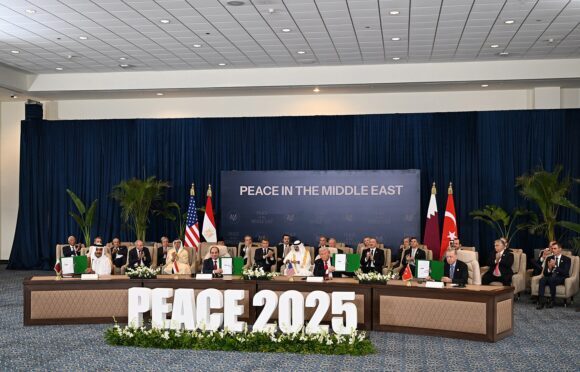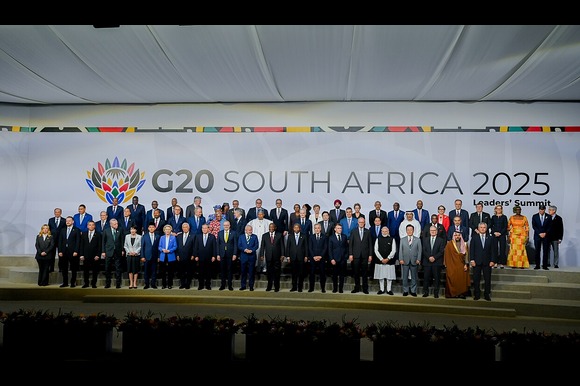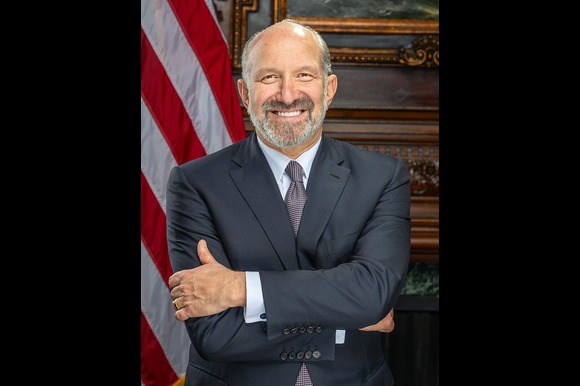
By President.az
Former U.S. President Donald Trump took center stage in a high-stakes peace summit held in Egypt’s Red Sea resort city of Sharm el-Sheikh, where he unveiled a comprehensive roadmap aimed at ending the ongoing Gaza conflict and rebuilding the war-torn region.
The meeting — co-chaired by Egypt and attended by over 20 global and regional leaders — concluded with the signing of a multinational declaration focused on ceasefire consolidation, humanitarian aid, and Gaza’s long-term political and security future.
Though both Hamas and Israel’s Prime Minister Benjamin Netanyahu were absent from the official signing, Trump’s proposal marked a significant diplomatic push intended to stabilize the Middle East. His plan, which outlines 20 policy points, links reconstruction efforts to demilitarization and governance reforms, with several nations agreeing to act as guarantors and oversight members.
While some diplomats hailed the event as a turning point in the Gaza peace process, others argued that the proposal lacked clarity on crucial political details such as Palestinian sovereignty and enforcement mechanisms.
Background and Timing of the Visit
Trump’s arrival in Sharm el-Sheikh came amid a fragile ceasefire agreement and a recent hostage exchange deal, both of which had reignited hope for a lasting resolution after two years of devastating warfare in Gaza.
The Sharm el-Sheikh Summit was jointly hosted by Egypt’s President Abdel Fattah el-Sisi, a key regional mediator, and brought together leaders from across the Arab world, Europe, and North America. Its stated goal was to transform the fragile truce into a structured peace process, beginning with immediate humanitarian coordination and long-term reconstruction planning.
The summit also represented a renewed attempt by Egypt to reaffirm its diplomatic leadership in regional peace initiatives, while Trump’s participation was widely viewed as an effort to reassert American influence in Middle Eastern diplomacy.
Trump’s Arrival and Summit Schedule
Upon landing in Egypt, Trump held several bilateral discussions with regional and Western leaders. His meeting with President Sisi was a highlight, focusing on humanitarian corridors, reconstruction logistics, and Gaza’s future governance framework.
The summit began with a formal opening session and a widely publicized group photo, symbolizing unity among attending nations. This was followed by speeches from co-chairs and attending heads of state, who collectively emphasized the need to translate the ceasefire into a sustainable peace.
A key moment of the visit was the signing ceremony, where Trump and other leaders endorsed a document — referred to alternately as the “Trump Peace Declaration” or “Sharm el-Sheikh Framework for Peace and Reconstruction.”
Trump’s keynote address underscored his signature themes of “peace through strength” and economic recovery through stability, urging all nations to participate in what he called the “Board of Peace” — a proposed oversight body that would guide Gaza’s transition.
Core Components of the Trump Plan
The declaration presented in Sharm el-Sheikh revolved around several key principles:
1. Humanitarian Priorities
Trump’s plan called for the rapid delivery of humanitarian assistance, including food, medical supplies, and temporary shelters. The document outlined new mechanisms to coordinate aid through international agencies, ensuring secure passage for convoys into Gaza’s hardest-hit areas.
2. Conditional Reconstruction
One of the plan’s central tenets is that international reconstruction funding would be conditional on Gaza’s demilitarization and the establishment of verified security controls. Donors agreed to release funds only after credible assurances that weapons stockpiles and militant activity had been dismantled.
3. Transitional Administration
The proposal envisions the creation of a temporary administrative council, or “Board of Peace,” composed of technocrats and regional representatives. This body would manage day-to-day civil affairs, reconstruction projects, and humanitarian operations under the supervision of an international coalition.
4. Security Framework
To maintain order and prevent renewed conflict, the plan suggests forming a U.S.-led military coordination center. This unit would work with regional security forces to monitor ceasefire compliance and oversee disarmament processes.
Participants and Political Context
The Sharm el-Sheikh summit saw the participation of more than 20 countries, including the United States, Egypt, Turkey, Qatar, Saudi Arabia, the United Arab Emirates, Jordan, France, Germany, and the United Kingdom.
However, the absence of Hamas and the non-attendance of Israeli Prime Minister Benjamin Netanyahu highlighted ongoing divisions. While Israel sent a lower-level delegation, Netanyahu’s office cited “scheduling reasons,” a move widely interpreted as political signaling.
For Trump, the event was both a diplomatic showcase and an opportunity to reinforce his image as a global negotiator. For Egypt, it reaffirmed Cairo’s historical role as a mediator between Israel and the Palestinian territories.
Observers, however, cautioned that the high-profile ceremony might have overshadowed the practical challenges of implementing such an ambitious plan.
Immediate Outcomes and Announcements
The summit produced a joint declaration that outlined a shared vision for peace and reconstruction. Among its key outcomes were:
- A collective agreement to accelerate humanitarian aid deliveries.
- A commitment to tie reconstruction to verified demilitarization of Gaza.
- A pledge to establish follow-up committees and working groups to translate the declaration into actionable steps.
Although the agreement lacked direct enforcement clauses, it provided a political framework for future negotiations and resource mobilization.
Donor nations also emphasized transparency and accountability, pledging to channel funds through monitored international institutions to avoid corruption or diversion.
Reactions and Global Response
Reactions to Trump’s Sharm el-Sheikh initiative were mixed.
Many world leaders welcomed the summit as a positive diplomatic breakthrough capable of ending prolonged hostilities and paving the way for rebuilding Gaza. Egyptian President el-Sisi described the event as the region’s “last chance for sustainable peace.”
International economists and analysts commended the plan’s emphasis on economic recovery and reconstruction, arguing that stability could not be achieved without rebuilding livelihoods.
Conversely, critics warned that the plan’s vague language on governance, statehood, and enforcement left major questions unanswered. Some regional actors expressed concern that making aid conditional on demilitarization might politicize humanitarian relief, potentially deepening divisions.
Challenges and Risks Ahead
Despite the optimism surrounding the summit, the implementation of the Trump Declaration faces formidable challenges:
- Lack of Hamas Involvement: The militant group’s exclusion from direct negotiations raises doubts about on-the-ground enforcement.
- Israeli Policy Ambiguity: Netanyahu’s absence and Israel’s cautious response suggest potential hurdles in coordinating border security and reconstruction access.
- Financial Oversight: Managing large-scale international funds in a volatile environment carries a high risk of misuse or corruption, demanding strict monitoring.
- Regional Rivalries: Diverging agendas among Gulf states, Iran, Turkey, and Western powers could undermine collective efforts if unity falters.
Next Steps and Short-Term Outlook
Analysts are closely watching several developments that will determine the plan’s viability in the coming months:
- Formation of Working Groups: The establishment of committees responsible for overseeing humanitarian aid, reconstruction logistics, and political transition.
- Humanitarian Access: Implementation of safe corridors and consistent delivery of relief supplies into Gaza.
- Security Verification: Deployment of monitoring teams to supervise the ceasefire and prevent renewed hostilities.
- Political Engagement: Potential re-engagement with Palestinian representatives and inclusion of local voices in the governance structure.
Analytical Assessment
The Sharm el-Sheikh Summit represented one of the most visible diplomatic efforts in the Middle East since the outbreak of the Gaza war. Trump’s reemergence as a mediator added political weight and media attention, yet the success of his plan depends largely on practical execution and broad political consensus.
Without participation from Hamas or firm Israeli commitment, implementation will remain uncertain. Nonetheless, the summit’s achievements — particularly the alignment of major powers around a shared framework — mark a symbolic yet significant step toward stability.
If the follow-up committees deliver on their promises, Sharm el-Sheikh may be remembered as the starting point for a genuine reconstruction and peace process. If not, it risks becoming another diplomatic milestone with limited real-world effect.




